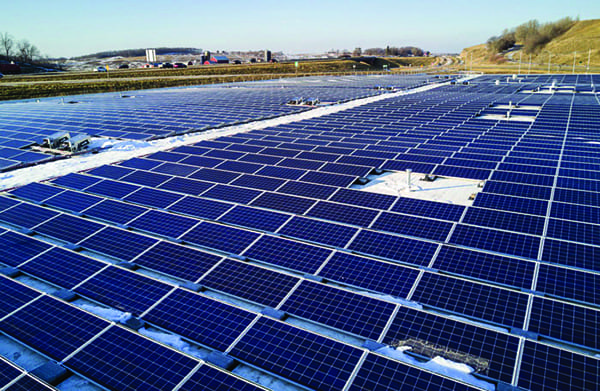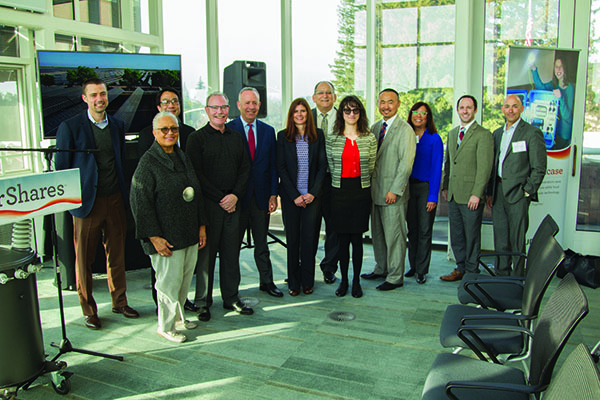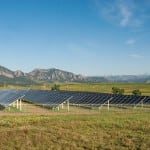Community solar projects, also known as solar farms or solar gardens, are maturing and moving forward. Minnesota leads the nation with 559 MW of capacity on the ground, and other states are following with new policy initiatives.
Community solar is on a roll. Bringing solar photovoltaic power to consumers who, for a variety of reasons, can’t put solar panels on their roofs—apartment dwellers don’t own roofs, many roofs aren’t oriented to catch the sun’s rays, or the roofs are obscured by natural and manmade obstacles—is gaining momentum and attracting investment.
The Solar Energy Industries Association (SEIA) reports that 1,387-MW of community solar have been installed through 2018. SEIA says, “Shared renewable energy arrangements allow several energy customers to share the benefits of one local renewable energy power plant. The shared renewables project pools investments from multiple members of a community and provides power and/or financial benefits in return.” The terms community solar, solar gardens, and solar farms are interchangeable.
Recent Community Solar Announcements
In June, Hannon Armstrong, a green power investor, and Summit Ridge Energy, a solar power developer, announced a plan to invest in community solar, starting in Maryland’s Prince George’s and Baltimore counties. Both are populous and prosperous suburban markets. With Hannon Armstrong financing, Summit Ridge is looking to build more than 250 MW of community solar over the next few years.
Also in June, the Wisconsin Public Service Commission approved community solar programs for investor-owned utilities Madison Gas & Electric (MGE) and Alliant Energy. MGE plans to build a 5-MW solar garden at a regional airport (Figure 1), 10 times the size of its current community solar installations. Alliant, meanwhile, plans a project where residential customers can buy panels at about $1,200/kW. The utility would pay the owners of the projects 6.3 cents/kWh for the power generated.
 |
|
1. Madison Gas and Electric (MGE) will add a 5-MW project to a shared-solar installation at the Middleton Municipal Airport in Wisconsin. The original 500-kW array, shown here, came online in January 2017 at Middleton’s Municipal Operations Center. Courtesy: MGE |
At the same time, in New York, Nautilus Solar Energy, which develops and manages utility and community solar projects, cut the ribbon on a 2.83-MW community solar project covering 15 acres, providing energy cost savings to some 300 homes in the Orange and Rockland utility service territory. The project has a $1 million grant from the New York State Energy Research and Development Authority.
In Nebraska, the Norfolk City Council in April approved an agreement with the statewide Nebraska Public Power District for an 8.5-MW project tied to a 1-MW battery storage demonstration, supported by a $490,000 two-year grant from the Nebraska Environmental Trust. It will be built on city land.
And in Minnesota, retail giant Walmart agreed to subscribe to 36 of United States Solar Corp.’s community solar projects in 13 counties. Several projects have completed construction. The rest are slated for the first half of 2020.
Community Solar Flourishes in the North Star State
Minnesota is the nation’s community solar leader with June operational capacity of 559 MW, more than a third of the national capacity. Minnesota’s legislature authorized the community solar program for Xcel Energy in 2013 as part of the state’s solar energy initiative. It took until January 2017 to see the first multiple megawatts of capacity in operation, according to Xcel’s figures.
“Minnesota’s program has finally matured,” John Farrell, who heads the Energy Democracy initiative at the Institute for Local Self-Reliance (ILSR), told POWER. Most other states, he said, pointing to Maryland and New York specifically, are seeing “the boom in policy development—not yet in fully operational projects.”
Minnesota’s community solar program has seen controversy. While Xcel must offer the program, the investor-owned utility doesn’t like many elements, seeking changes including limiting the scale and size of the projects. An Xcel written statement says, “More than 90 percent of the community solar garden benefits go to commercial customers who participate, which costs, expected to be more than $170 million in 2019, are borne by all Minnesota customers, more than 95 percent of whom don’t participate in the program.”
Xcel worked with the Republican majority in the state Senate this spring to advance programmatic rollbacks. Democrats, controlling the Minnesota House, pushed to expand the program, aiming it more directly at low-income customers. Gridlock ensued, Farrell noted. No changes resulted.
The Republican argument against the program, somewhat ironically, was that it was too good for business. State Rep. Pat Garofalo (R-Farmington) said, “What it’s turned into is a big bonus for business, and that the best way to use solar to combat greenhouse gas emissions is utility-scale solar.”
Farrell acknowledges that “most of the program’s total capacity continues to serve commercial customers (87%),” but that a large portion also serves “public entities such as schools, hospitals, and county and local governments.”
Solar Gardens Act Started the Trend
Farrell said the community solar movement got rolling in 2010, when the Colorado state legislature passed the Community Solar Gardens Act. “What we saw in Colorado was a business model that could work elsewhere,” he said. Minnesota quickly followed with its own legislation.
Greentech Media noted that after nine years, Colorado remains among the largest programs in terms of installed capacity, but is slipping. “Compared to other programs in the country, at this point it is way behind,” said Paul Spencer, CEO of Clean Energy Collective, a community solar developer that installed Colorado’s first project. “It just hasn’t evolved with the times.”
Farrell said the key issue behind Minnesota’s growth and Colorado’s stagnation is the capacity cap. Colorado’s program caps community solar projects at 6.5 MW per utility per year. Minnesota has no cap. Xcel wanted a 25-MW cap, but the legislature failed to adopt that this year.
Most community solar projects are financed and owned by what ILSR’s Farrell calls “tax equity” financiers. A 30% federal solar investment tax credit has been in place for years, including 2019. It declines to 26% in 2020 and slips further by 2022. Investors put up the capital and sell power to the local utility, which then distributes the rewards to the customers who have subscribed to the project. The financier “captures most of the benefits in the first few years,” he said. In Minnesota, Xcel is prohibited from owning the projects. Some projects are owned by the subscribers, although that is rare.
Municipal utilities and rural electric cooperatives have a relatively long history with community solar. In 2010, the Department of Energy’s National Renewable Energy Laboratory published A Guide to Community Solar: Utility, Private, and Non-profit Project Development. It cites several public power community solar projects then underway, including the SolarShares program (Figure 2) at the Sacramento Municipal Utility District and Colorado’s United Power co-op Sol Partners venture.
 |
|
2. Leaders from the California Department of General Services, Sacramento Regional County Sanitation District, Sacramento Area Sewer District, Sacramento County Department of General Services, City of Sacramento, Los Rios Community College District, and San Juan Unified School District joined together to recognize SolarShares agreements equal to enough solar electricity to power 22,000 homes for a year. Courtesy: Sacramento Municipal Utility District |
Paul Zummo, director of policy research and analysis at the American Public Power Association, told POWER, “We’ve seen a consistent trend. More and more utilities are implementing community solar. We’re entering a phase with a lot of experience. So, it’s mature. Now we are starting to see more storage combined with solar. I can see storage in most cases enhancing a project, especially as we see prices for storage come down.”
Zummo said tax equity financing is also the dominant municipal financing model. “The utility doesn’t want to take on the investment itself, and there are also tax credits in play. Only a handful of utilities own the projects outright.”
Community solar, Zummo said, “has been a good resource for a lot of our members. It’s a way to serve customers who otherwise wouldn’t have access to solar generation. Most of our members look at it positively. Customers seem extremely satisfied, and it’s been successful from a financial standpoint.”
New Initiatives Springing Up Nationwide
Building on Minnesota’s success, several states have adopted new solar initiatives. In Maryland, the Democratic legislature this year passed and Republican Gov. Larry Hogan signed a bill liberalizing the state’s community solar program. The legislation keeps the pilot community solar program through 2022, when the state’s Public Service Commission is supposed to deliver a new long-term path for the program.
The Maryland law raises the maximum capacity for a community solar project to 2 MW and abolishes a limit on the maximum number of subscribers to a project. But the pilot program still will operate under an original provision of a total limit on community projects statewide of 196 MW. Also, 30% of the capacity is set aside for low-to-moderate income customers and another 30% for brownfield sites.
At the end of June, the Maine legislature passed two bills to boost community solar. The state resisted solar during the administration of hard-right Republican Gov. Paul LePage, who was limited to two terms. The state has only 55 MW of installed solar capacity. Maine elected Democrat Janet Mills in 2018, a strong renewables supporter.
The new laws in Maine call for 400 MW of solar to be developed in the state, increasing the reach of community solar. The National Law Journal said, “Previously, one could only have a community solar deal with nine or less subscribers.” Now, with the passage of LD 1711, that number is 200 and the net metering cap is 2 MW, up from 600 kW. Separate legislation jumps the state Renewable Portfolio Standard to 80% by 2030 and 100% by 2050.
In New York, regulators this spring approved changes in how community solar facilities get paid, which could boost financing. The New York Public Service Commission rules adopted changes to its “value stack” payment method, which includes a value for demand reduction for distributed energy resources. The change allows inclusion of “anchor tenants,” similar to those in shopping malls, for community solar projects, which analysts have said could encourage project financing.
What’s ahead for community solar? ILSR’s Farrell says he’s looking to see how the phaseout of investment tax credits will affect the market. “Things could change a lot as the tax credit expires,” he said. “We might see more direct ownership structures without tax equity finance. That could keep more of the dollars with the subscribers and owners.” He said that as solar technology develops, “We might get enough economies of scale that there is no need for tax subsidies.”
Farrell added that he’s troubled by the attitudes of some climate change advocates, who, he said, “are not concerned who owns solar and how much it costs.” They want solar at any cost. “The tensions are whether the consumer advocates are going to be with the solar advocates.” He said that with community solar, “We can save people money. Community solar is a way for democratizing the wealth. But not everybody is on board with that. It’s an interesting political issue.” ■
—Kennedy Maize is a long-time energy journalist and a frequent contributor to POWER.









